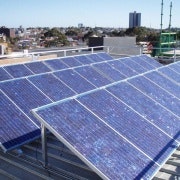Will solar offset its residential slump?
*Each year SunWiz and SolarBusinessServices team up to provide Australia’s most-respected solar photovoltaic industry forecast. This document provides valuable guidance for what’s to come for solar businesses, banks, governments, regulators and grid operators. It differs from other forecasts in its superior accuracy, extensive research, depth of coverage and local knowledge (we live and breathe this stuff). For example, last year our forecast was 98 per cent accurate (SolarBuzz can’t even get last year’s data correct). As a highly-valuable document which fetches $4400 a pop, there are natural limitations to what we reveal publicly, but we’re happy to present some noteworthy trends for your digestion.
We expect that 2014 is likely to be another year of slight contraction, especially focused in the residential sector but offset in part by the commercial and utility sector.
The end of feed-in tariffs in Queensland and South Australia stimulated the market above the underlying levels experienced in other states, so the removal of these influences combined with other possible poor-case outcomes will lead to as much as a 45 per cent contraction of the residential market.
Much hinges on the future of the Small-scale Renewable Energy Scheme, with the One Million Solar Roofs policy unlikely to compensate; any transfer of support will be problematic because it would shift from a consumer-funded scheme (whose costs have just halved) to a budget-funded mechanism with all of its consequent uncertainty.
Perhaps of equal concern is the One Million Solar Roofs policy is suggested to come from the Australian Renewable Energy Agency’s pockets, even though ARENA has insufficient non-committed funds available, having directed funding towards programs that will support utility-scale PV (Million Solar Roofs to be scrapped? January 30). ARENA’s Regional Australia’s Renewables program and potential funding of Solar Flagships runners-up could fund as much as 200 MW of large-scale PV proceed in coming years, an almost six-fold increase on Australia’s current large-scale tally.
Misdirecting such funding towards One Million Solar Roofs would probably deliver about 50MW per year of PV while funding remained available, a marginal increase in 3GW of existing residential capacity thus providing insignificant industry benefit.
Utility-scale PV will be of major significance to the Australian PV industry. Installations of Solar Flagships and ACT Solar Auction winners should see 150MW worth installed in 2014, with the sector’s future dependent upon ARENA and the LRET. Large-scale commercial PV is expected to be one of the least-cost sources of LGCs by the end of the decade, and utility-scale solar projects are also likely to become viable in 2019 and 2020, so long as healthy LGC prices remain.
However, if the target is reduced then large-scale PV will be most affected, because there will be insufficient LGC demand when PV becomes competitive. In essence, a cut to the LRET target will wipe out the large-scale solar sector, and foreign companies will immediately divest from Australia. By contrast, it may be that delaying the 41,000 GWh trajectory out to 2025 would delay commercial PV but ultimately favour it, because it will give solar a longer period in which it as a LGC supply can be competitive with wind.
The flow-on effects from any adjustment to the LGC target will be compounding. The 2014-2018 forecast released this week by SunWiz and SolarBusinessServices demonstrates the reliance of utility-scale PV upon ARENA funding. As ARENA has a limited pool of funds to utilise in bridging the ever-narrowing competitiveness gap for early projects, then a reduced LGC price will reduce project competitiveness, meaning ARENA needs to use more funds on each project and can thus support fewer projects. Depending on that funding, 25 per cent of capacity installed in 2015 may attract LGCs.
Despite the forthcoming prominence of the utility-scale solar sector, the problem for most Australian solar businesses is the lack of opportunity to participate in this sector, particularly considering that most projects are already contracted.
Thankfully, the small-to-medium commercial PV sector continues to grow at a healthy rate.
Though unlikely to entirely offset the residential fallback in 2014, small-to-medium commercial PV will continue to increase in significance.
The importance of the commercial market will drive further financial offerings such as leases and power purchase agreements, which of course need to be supported by detailed financial analysis that incorporates load profile considerations provided by such tools as 'PVsell'.
Though regulators, banks, and PV wholesalers may be most interested in the national tally, network operators and PV companies operate at a more regional level.
So too, the solar opportunity varies markedly by location, meaning sub-sector analysis is crucial. For example, despite its government’s best efforts to cull solar support, Queensland is likely to remain the leading market for residential PV, particularly as residential electricity prices there have some catching up to do.
By contrast, NSW is the leading market for commercial PV, the unbundled electricity tariffs in that state being substantially higher than Queensland’s equivalent commercial tariffs.
Warwick Johnston is managing director of Sunwiz Consulting.
SunWiz/SBS Forecast is the only PV market forecast to break down the market opportunity into state and segment over the coming five years. Understanding where to focus is essential for any company operating in Australia.
Based on the combined knowledge of Australia's leading solar industry analysts, this 90 page report includes 58 different graphs and tables describing the latest market segment statistics combined with insightful commentary. Also included in the forecast is an analysis of the top PV businesses of 2013, and identification of the top postcodes for solar power in recent times. The Australian PV Market Forecast 2013-2018 can be ordered from http://www.sunwiz.com.au/index.php/solar-market-intelligence/market-forecast.html for $4000 ex GST.













